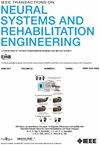由神经数据驱动的个性化α-运动神经元池模型编码了控制力量发展速度的机制。
IF 4.8
2区 医学
Q2 ENGINEERING, BIOMEDICAL
IEEE Transactions on Neural Systems and Rehabilitation Engineering
Pub Date : 2024-09-25
DOI:10.1109/TNSRE.2024.3467692
引用次数: 0
摘要
中枢神经系统会根据任务需求采用不同的运动控制策略。因此,支配骨骼肌纤维的α-肌元(MN)池的活动会根据肌肉力量和力量发展速度(RFD)进行调节。在人体中,生物物理 MN 模型能够在体内推断出这种调制的神经过程(如突触输入、整个 MN 池的活动等),否则就很难进行实验测量。由于个体具有独特的神经生理学特征,这些模型的个性化对于研究人类的运动控制至关重要。因此,本研究利用由体内常见突触输入估计值(即来自表面高密度肌电图)驱动的特定个体 MN 池模型,研究了 RFD 调节的相关机制。具体来说,我们评估了体内 MN 活动在 RFD 和肌力之间的变化情况。这包括完整 MN 池中的招募和速率编码调节,以及基于模型的兴奋性突触增益(ΔIF)估计。我们发现 MN 活动中 RFD 特异性的变化与 ΔIF 的变化相关。此外,我们还发现,由 RFD 特异性 ΔIF 驱动的 MN 池模型再现了不同 RFD 下的活体 MN 发火特征和相关力曲线。总之,这项工作标志着我们在模拟人类发力机制和创建脊髓回路特异性模型方面迈出了一步。这将为研究体内人体神经力学和运动恢复干预打开一扇窗。本文章由计算机程序翻译,如有差异,请以英文原文为准。
Personalized Alpha-Motoneuron Pool Models Driven by Neural Data Encode the Mechanisms Controlling Rate of Force Development
The central nervous system employs distinct motor control strategies depending on task demands. Accordingly, the activity of alpha-motoneuron (MN) pools innervating skeletal muscle fibers is modulated based on muscle force and rate of force development (RFD). In human subjects, biophysical MN models enable inferring in vivo the neural processes (e.g., synaptic input, activity of the entire MN pool, etc.) underlying this modulation, which are otherwise challenging to measure experimentally. Due to unique neurophysiological characteristics of individuals, personalizing these models is essential to study motor control in humans. Therefore, this work studied the mechanisms involved in the modulation of RFD using person-specific MN pool models driven by in vivo common synaptic input estimates (i.e., derived from surface high-density electromyography). Specifically, we assessed how in vivo MN activity changed across RFD and muscle force. This included modulation of recruitment and rate coding in the complete MN pool, as well as model-based estimates of excitatory synaptic gains (
$\Delta $
IF). We found RFD-specific changes in MN activity associated to changes in
$\Delta $
IF. Moreover, we showed that MN pool models driven by RFD-specific
$\Delta $
IFs reproduced in vivo MN firing features and associated force profiles at different RFDs. Altogether, this work represents a step towards modelling the mechanisms of force generation in humans and creating person-specific models of the spinal circuitry. This will open a window for studying in vivo human neuromechanics and motor restoring interventions.
求助全文
通过发布文献求助,成功后即可免费获取论文全文。
去求助
来源期刊
CiteScore
8.60
自引率
8.20%
发文量
479
审稿时长
6-12 weeks
期刊介绍:
Rehabilitative and neural aspects of biomedical engineering, including functional electrical stimulation, acoustic dynamics, human performance measurement and analysis, nerve stimulation, electromyography, motor control and stimulation; and hardware and software applications for rehabilitation engineering and assistive devices.

 求助内容:
求助内容: 应助结果提醒方式:
应助结果提醒方式:


